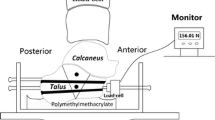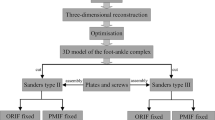Abstract
The objective of the study was to investigate the stress changes in the posterior articular surface of the calcaneus following alternation of the calcaneal varus angle in normal calcaneus and discuss the clinical significance of the calcaneal varus angle. Axial view radiographs of 165 volunteers were obtained to measure the calcaneal varus angle of normal calcaneus. A calcaneal model with different varus angle changes (including +2°, +4°, +6°, −2°, −4°, and −6°) was established using Creo 2.0 software. Stress changes at different calcaneal varus angles in the posterior articular surface of the calcaneus under a load of 100 N were measured. Stressed areas in posterior articular facets were slightly fewer following +2°, +4°, and +6° changes in varus angle than in normal varus angles with stress concentering regions moving to the anteromedial aspect of the posterior calcaneal facet. However, stress concentering areas in posterior calcaneal facets following −4° and −6° changes in varus angle obviously moved to the anterior and posterior medial side of posterior calcaneal facets. Stress distribution in the posterior articular surface of the calcaneus varies with the calcaneal varus angle. The decrease in calcaneal varus angle following operative treatment of calcaneal fractures should be controlled within 2°.








Similar content being viewed by others
References
Abdul-Kadir MR, Hansen U, Klabunde R, Lucas D, Amis A (2008) Finite element modelling of primary hip stem stability: the effect of interference fit. J Biomech 41:587–594. doi:10.1016/j.jbiomech.2007.10.009
Bagaria V, Deshpande S, Rasalkar DD, Kuthe A, Paunipagar BK (2011) Use of rapid prototyping and three-dimensional reconstruction modeling in the management of complex fractures. Eur J Radiol 80:814–820. doi:10.1016/j.ejrad.2010.10.007
Bevill G, Keaveny TM (2009) Trabecular bone strength predictions using finite element analysis of micro-scale images at limited spatial resolution. Bone 44:579–584. doi:10.1016/j.bone.2008.11.020
Buckley RE, Meek RN (1992) Comparison of open versus closed reduction of intraarticular calcaneal fractures: a matched cohort in workmen. J Orthop Trauma 6:216–222
Buckley RE, Tough S (2004) Displaced intra-articular calcaneal fractures. J Am Acad Orthop Surg 12:172–178
Cheung JT, Zhang M, Leung AK, Fan YB (2005) Three-dimensional finite element analysis of the foot during standing—a material sensitivity study. J Biomech 38:1045–1054. doi:10.1016/j.jbiomech.2004.05.035
Epstein N, Chandran S, Chou L (2012) Current concepts review: intra-articular fractures of the calcaneus. Foot Ankle Int 33:79–86. doi:10.3113/FAI.2012.0079
Gefen A (2002) Stress analysis of the standing foot following surgical plantar fascia release. J Biomech 35:629–637
Guerado E, Bertrand ML, Cano JR (2012) Management of calcaneal fractures: what have we learnt over the years? Injury 43:1640–1650. doi:10.1016/j.injury.2012.05.011
Huang ZH, Li J, Chen RQ, Du JW, Zhang JX (2012) Three-dimensional finite element analysis of calcaneal fractures. Zhongguo Gu Shang 25:97–101
Loucks C, Buckley R (1999) Bohler’s angle: correlation with outcome in displaced intra-articular calcaneal fractures. J Orthop Trauma 13:554–558
Marschollek M, Teistler M, Bott OJ, Stuermer KM, Pretschner DP, Dresing K (2006) Pre-operative dynamic interactive exploration of complex articular fractures using a novel 3D navigation tool. Methods Inf Med 45:384–388
Ni M, Weng XH, Mei J, Niu WX (2014) Primary stability of absorbable screw fixation for intra-articular calcaneal fractures: a finite element analysis. J Med Biol Eng 35:236–241
Pang QJ, Yu X, Guo ZH (2014) The sustentaculum tali screw fixation for the treatment of Sanders type II calcaneal fracture: a finite element analysis. Pak J Med Sci 30:1099–1103. doi:10.12669/pjms.305.5301
Rudang R, Darelid A, Nilsson M, Mellstrom D, Ohlsson C, Lorentzon M (2013) X-ray-verified fractures are associated with finite element analysis-derived bone strength and trabecular microstructure in young adult men. J Bone Miner Res 28:2305–2316. doi:10.1002/jbmr.1974
Shim VB, Fernandez JW, Gamage PB, Regnery C, Smith DW, Gardiner BS, Lloyd DG, Besier TF (2014) Subject-specific finite element analysis to characterize the influence of geometry and material properties in Achilles tendon rupture. J Biomech 47:3598–3604. doi:10.1016/j.jbiomech.2014.10.001
Simkin A, Stokes IA (1982) Characterisation of the dynamic vertical force distribution under the foot. Med Biol Eng Comput 20:12–18
Wu Z, Su Y, Chen W, Zhang Q, Liu Y, Li M, Wang H, Zhang Y (2012) Functional outcome of displaced intra-articular calcaneal fractures: a comparison between open reduction/internal fixation and a minimally invasive approach featured an anatomical plate and compression bolts. J Trauma Acute Care Surg 73:743–751. doi:10.1097/TA.0b013e318253b5f1
Author information
Authors and Affiliations
Corresponding author
Ethics declarations
Conflict of interest
The authors have no competing interest to declare.
Rights and permissions
About this article
Cite this article
Zhang, Xb., Wu, H., Zhang, Lg. et al. Calcaneal varus angle change in normal calcaneus: a three-dimensional finite element analysis. Med Biol Eng Comput 55, 429–437 (2017). https://doi.org/10.1007/s11517-016-1527-4
Received:
Accepted:
Published:
Issue Date:
DOI: https://doi.org/10.1007/s11517-016-1527-4




